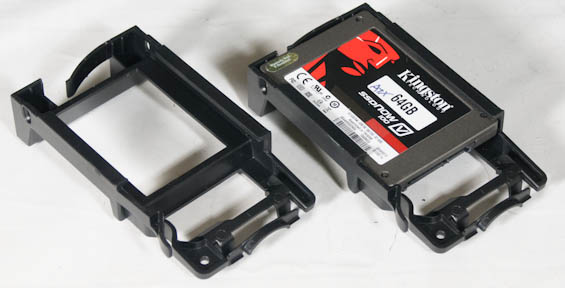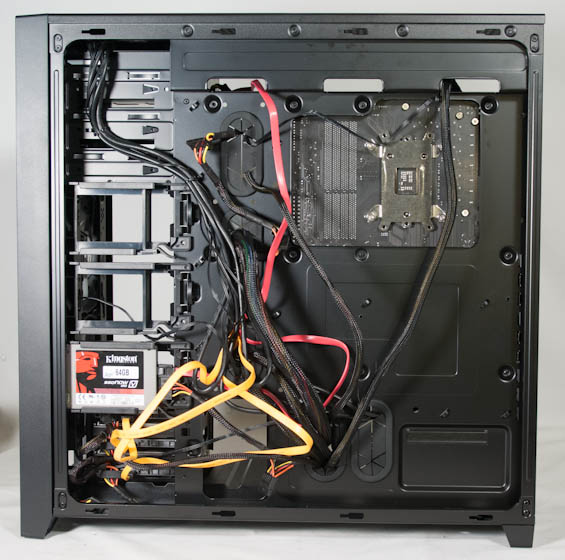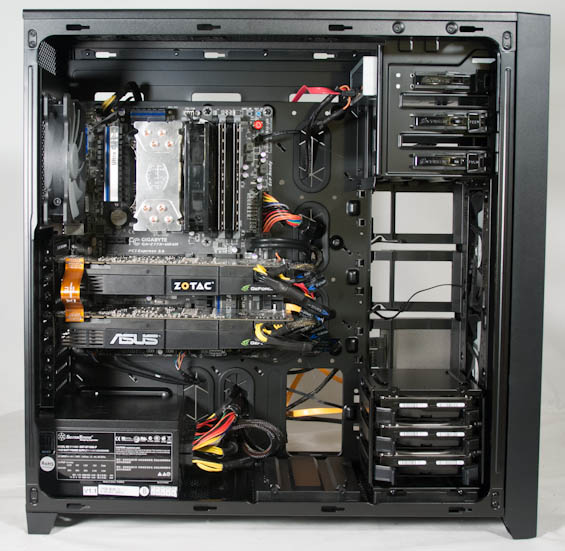Corsair Obsidian 750D Case Review
by Dustin Sklavos on September 24, 2013 6:00 AM EST- Posted in
- Cases/Cooling/PSUs
- Corsair
- ATX
- Case
If it weren't for the weight, assembling a system in the Corsair Obsidian 750D would almost be like a vacation. Corsair's trademark at this point is ease of use, and that continues with the 750D.
The side panels are both hinged and held in place with two thumbscrews. From there, installing the I/O shield and motherboard is easy; Corsair has extruded all of the motherboard mounting points from the tray itself, and added a guide peg in the center. There's also plenty of space surrounding the motherboard, making it easy to route cabling.
With all of the different drive form factors having toolless installation, you can imagine how easy that was to handle as well. The 3.5" drive trays are typical of Corsair, but they snap in nicely and securely (as opposed to the NZXT trays which have a hard time staying in place). NZXT handily beats Corsair's toolless retention mechanism for the 5.25" drive bays, though; Corsair's isn't bad, but NZXT's is incredibly secure. You'll probably want to screw in the drive on the opposite side just to be safe.

Corsair has been pursuing toolless mounting solutions for 2.5" drives pretty aggressively; they use modular, interlocking drive caddies for the Carbide Air 540, and those work well. With the 750D they have an even more novel approach, with a series of caddies that bridge the motherboard tray and front of the case. This system is also a pretty effective one, but if you're using a 7mm drive it's going to be a little loose. I'm not sure what they can really do about this. Create tiny drive cages and tiny drive trays that snap in on the sides? The arrangement of the 2.5" caddies behind the motherboard tray in the 750D is slick, but their alignment complicates cabling somewhat.

The power supply and expansion cards went in easily and smoothly, and cabling for the most part was a non-issue. Corsair's creative 2.5" drive solution does cause some minor problems, though. You can see where the bottom drive caddie would be that the cables from the 3.5" drives bunch up, and that's ignoring how the front fan cables have to route through one of the other caddies. The fan cables aren't a major issue, but the leads for the 3.5" drives are a problem waiting to happen. Kudos to Corsair for coming up with an innovative arrangement for the 2.5" drives, hopefully they can work out some of the kinks in a future revision.

For how hideous my cabling job is, Corsair designs continue to lend themselves well to very clean interior builds. As a teenager I was huge on the idea of having a windowed case, then through most of my twenties I was interested in having a more modest machine. As I've gotten older (and broken thirty) and case designs have gotten more elegant, I've started to see the appeal in having a slightly more showy build. The 750D's window is welcome; it's able to handle our full fat testbed with aplomb, and makes even my crappy wiring look decent.


_thumb.jpg)
_thumb.jpg)
_thumb.jpg)
_thumb.jpg)
_thumb.jpg)
_thumb.jpg)








40 Comments
View All Comments
just4U - Wednesday, September 25, 2013 - link
Totally agree.. and with that said here's my current system http://imageshack.us/a/img545/9060/g45f.jpg and yes it has a window! (Corsair 350D)pdjblum - Tuesday, September 24, 2013 - link
You continue to be dismissive and arrogant by refusing to even acknowledge by constant complaint about not listing the bill of materials in the spec table. Here is the spec table from the review on bit-tech.net that was also published today:Specifications
Dimensions (mm) 235 x 546 x 560 (W x D x H)
Material Steel, plastic
Available colours Black
Weight 9.5kg
Front panel Power, reset, 2 x USB 3, 2 x USB 2, stereo, microphone
Drive bays 3 x external 5.25in, 6 x internal 3.5in/2.5-in, 4 x dedicated 2.5in
Form factor(s) E-ATX, ATX, micro-ATX, mini-ITX
Cooling 2 x 120/140mm front fan mounts (2 x 140mm fans included), 1 x 120/140mm rear fan mount (140mm fan included), 3 x 120/140mm top fan mounts (fan not included), 2 x bottom 120mm fan mounts (fans not included)
CPU cooler clearance 180mm
Maximum graphics card length 460mm (340mm in extreme low slot with storage caddie installed)
Extras Removable dust filters
Too bad you cannot do the same.
jdon - Tuesday, September 24, 2013 - link
And you continue to be arrogant by refusing to even acknowledge that you are a reader, not an editor. Take a powder, and cut Dustin a little slack or ask nicely. We can Google any information we want that isn't here.Too bad you cannot quietly do the same.
pdjblum - Tuesday, September 24, 2013 - link
I have asked nicely numerous times to date, but he has not even responded. The review is not complete without the build materials, and a reader should not have to search outside of the review to find out something as pertinent as this. I would have not been such a big shot and responded to one of my polite comments over the years already.just4U - Wednesday, September 25, 2013 - link
Yes but that certainly doesn't mean he's being arrogant or pig-headed about it. Dustin's pretty damn good about fielding questions/comments about his articles.A5 - Tuesday, September 24, 2013 - link
What is in that list that isn't in the table on page 1? The dust filters?LB-ID - Tuesday, September 24, 2013 - link
Dustin, whatever HAS happened to Antec? They really used to be the market leader in cases, and now they just seem to have whimpered quietly off into the night.HisDivineOrder - Tuesday, September 24, 2013 - link
Can't wait for the inevitable cube-shaped Obsidian case. Hope they go 550D and try to make it silent, but deadly with lots of fan ports. Also, they can toss the window and give me some places for GPU cooling on the side instead.Too many windows of late, too few places for GPU cooling.
Teizo - Tuesday, September 24, 2013 - link
More like 350D's big brotherjust4U - Wednesday, September 25, 2013 - link
Yep